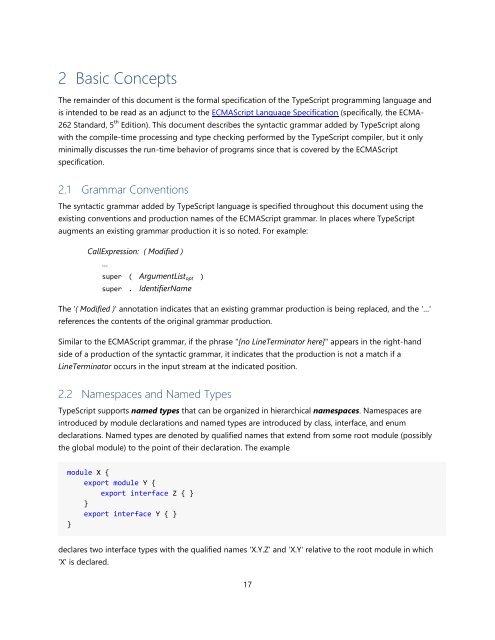TypeScript Language Specification v1.5
TypeScript Language Specification v1.5
TypeScript Language Specification v1.5
Create successful ePaper yourself
Turn your PDF publications into a flip-book with our unique Google optimized e-Paper software.
2 Basic Concepts<br />
The remainder of this document is the formal specification of the <strong>TypeScript</strong> programming language and<br />
is intended to be read as an adjunct to the ECMAScript <strong>Language</strong> <strong>Specification</strong> (specifically, the ECMA-<br />
262 Standard, 5 th Edition). This document describes the syntactic grammar added by <strong>TypeScript</strong> along<br />
with the compile-time processing and type checking performed by the <strong>TypeScript</strong> compiler, but it only<br />
minimally discusses the run-time behavior of programs since that is covered by the ECMAScript<br />
specification.<br />
2.1 Grammar Conventions<br />
The syntactic grammar added by <strong>TypeScript</strong> language is specified throughout this document using the<br />
existing conventions and production names of the ECMAScript grammar. In places where <strong>TypeScript</strong><br />
augments an existing grammar production it is so noted. For example:<br />
CallExpression: ( Modified )<br />
…<br />
super ( ArgumentList opt )<br />
super . IdentifierName<br />
The '( Modified )' annotation indicates that an existing grammar production is being replaced, and the '…'<br />
references the contents of the original grammar production.<br />
Similar to the ECMAScript grammar, if the phrase "[no LineTerminator here]" appears in the right-hand<br />
side of a production of the syntactic grammar, it indicates that the production is not a match if a<br />
LineTerminator occurs in the input stream at the indicated position.<br />
2.2 Namespaces and Named Types<br />
<strong>TypeScript</strong> supports named types that can be organized in hierarchical namespaces. Namespaces are<br />
introduced by module declarations and named types are introduced by class, interface, and enum<br />
declarations. Named types are denoted by qualified names that extend from some root module (possibly<br />
the global module) to the point of their declaration. The example<br />
module X {<br />
export module Y {<br />
export interface Z { }<br />
}<br />
export interface Y { }<br />
}<br />
declares two interface types with the qualified names 'X.Y.Z' and 'X.Y' relative to the root module in which<br />
'X' is declared.<br />
17


















